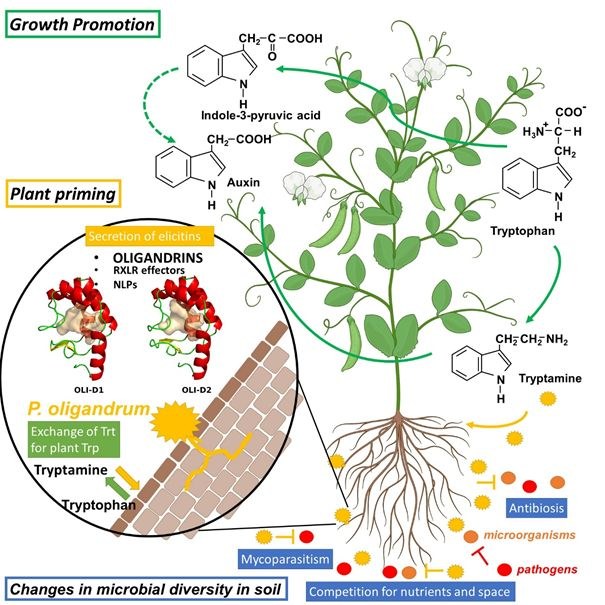Do you want to protect plants ecologically and effectively? Try using Pythium oligandrum!
The oomycete Pythium oligandrum is a globally spread soil organism that was first described by the American mycologist Charles Drechsler in 1930. This organism can be found on the surface of plant roots (in the rhizosphere) where it may interact with numerous plant pathogens, including pathogenic fungi, bacteria and other oomycetes, as well as the plant itself. In their recent review, our colleagues focus on P. oligandrum as a biological control agent and put into context biochemical processes underlying its positive effects in the plant protection.
For example, P. oligandrum degrades host cell wall polysaccharides using chitinases, cellulases, endo-β-1,3-glucanases, and various exoglycosidases. Proteases from various classes also participate in the cell wall hydrolysis. All these processes can modify cell surface structures and help P. oligandrum compete for space and nutrition. Accordingly, enzyme secretion most likely plays a key role in plant root colonisation.
Plant-P. oligandrum interactions, nevertheless, do not involve tissue injury but instead activate plant defence mechanisms, thereby strengthening future plant responses to pathogen attacks. This priming induces the phenylpropanoid and terpenoid pathways and thus synthesis of secondary metabolites, including lignin, for cell wall fortification and other metabolic adjustments. Such metabolic changes are mediated by elicitins, cell wall glycoproteins and oligandrins produced by P. oligandrum. The review presents models of oligandrins and cell wall glycoproteins from P. oligandrum constructed on the basis on β-cinnamomin from Phytophthora cinnamomi. It also summarizes information on newly identified elicitins – necrosis-inducing (NLP) proteins, RLXR (specific domain) proteins that may also affect plant physiology. This indicates a much more complex effect of P. oligandrum on plants than the hitherto known jasmonate-ethylene pathway. P. oligandrum also provides plant with tryptamine used for phytohormone auxin synthesis, thus promoting plant growth. Plant metabolic and phytohormonal changes after P. oligandrum inoculation are also discussed.
Thus, P. oligandrum has a remarkable ability not only to directly protect plants through mycoparasitism, but also to activate plants to defend themselves against phytopathogens. In addition, P. oligandrum stimulates plant growth through the delivery of tryptamine to plant roots. Since P. oligandrum can protect plants at several different levels, it represents a highly valued, useful and environmentally friendly means of biological plant protection.
Bělonožníková, K., Hýsková, V., Chmelík, J., Kavan, D., Čeřovská, N., Ryšlavá, H.: Pythium oligandrum in plant protection and growth promotion: Secretion of hydrolytic enzymes, elicitors and tryptamine as auxin precursor, Microbiological Research, Volume 258, 126976, 2022. https://doi.org/10.1016/j.micres.2022.126976

Document Actions